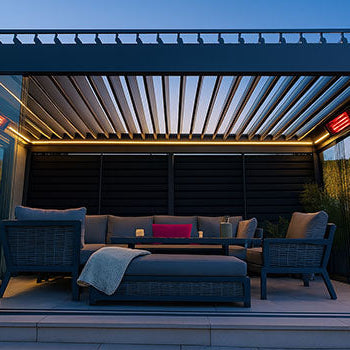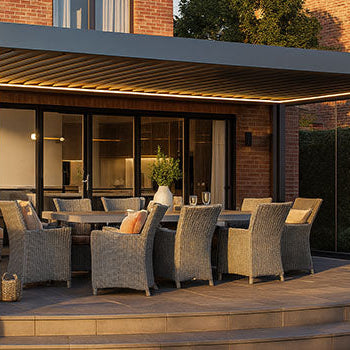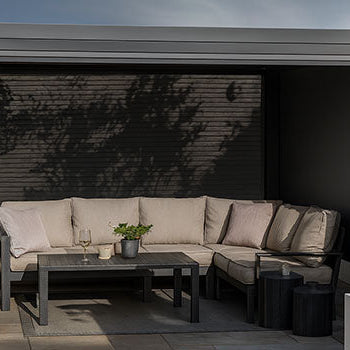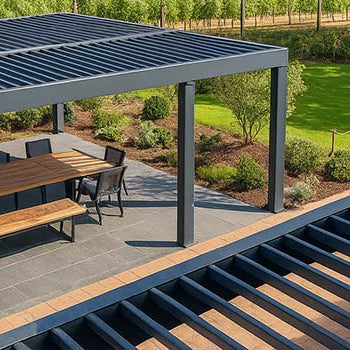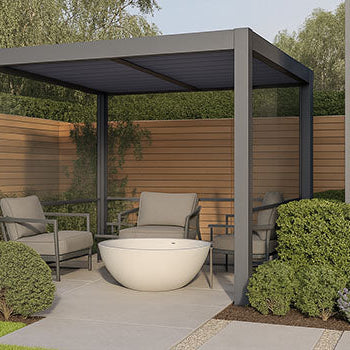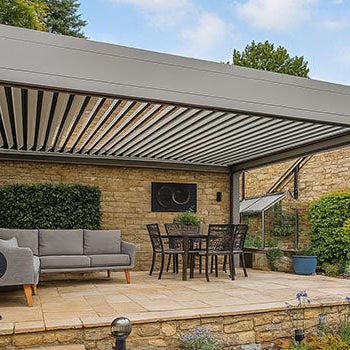Windy garden days are great for drying laundry... but not so great for flimsy pergolas. So, are pergolas wind resistant?
Short answer: not always, but they absolutely can be. With the right setup, anchoring, and materials, you can stop your pergola from turning into a giant garden kite. Keep reading to find out how to build a pergola that laughs in the face of a storm.

Pergola Wind Resistance: A Key Consideration in the UK
Let’s face it, the British weather doesn’t mess around. One minute you’re basking in sunshine, the next your barbecue's airborne. If you’ve got or are planning a pergola, wind resistance isn't optional, it’s essential.
A pergola should be more than pretty. It needs to stay in place when the wind picks up. Here's where design plays a major role.
How a Pergola's Open Design Interacts with Wind
Pergolas are loved for their airy, open structure. But that open design can become a problem when strong winds blow through. Instead of blocking wind, they let it pass around and through, sounds good, right?
It is... until those gusts catch a beam, bounce off your walls, or create unexpected lift. Without good anchoring and design, even an open pergola can get rocked.
Understanding Wind Load and Uplift Forces
Ever seen a trampoline fly? That’s wind load and uplift in action.
Wind load is the pressure wind puts on a structure. Uplift happens when wind slides under your pergola roof or beams, trying to lift it up and away. These forces need to be balanced by solid foundations and clever engineering.
Factors That Determine a Pergola's Wind Resistance
So, what actually makes a pergola hold up in a storm? A few key factors can make or break your setup.
The Importance of Strong Foundations and Anchoring
No matter how sleek your pergola looks, it won’t survive a windstorm if it’s not bolted down.
You’ll need concrete footings, deep post inserts, and proper hardware like steel brackets. Freestanding models are especially vulnerable, think of them like tents without pegs. You wouldn't trust that in a gale, would you?
Material Strength: Aluminium and Steel vs. Wood and Vinyl
Not all pergolas are created equal.
Aluminium and steel pergolas tend to be sturdier, more resistant to twisting and warping, and better suited for high-wind areas. Wood is beautiful but requires weatherproofing and regular checks for rot. Vinyl? Affordable, but often too lightweight unless reinforced properly.
The Impact of Pergola Size and Height
Bigger pergola, bigger target.
Tall, wide structures catch more wind, increasing the pressure on posts and footings. If you’re in a breezy area, consider a low-profile, compact pergola with fewer flat surfaces. Think smart, not supersized.
Freestanding vs. Wall-Mounted (Lean-To) Designs
Wall-mounted pergolas are your best friend in stormy weather. They borrow strength from your home, offering more stability than freestanding options.
Freestanding models need extra anchoring and can shift or tip if not properly secured. Lean-tos keep things tight and tidy.

How to Make a Pergola More Wind Resistant
Planning ahead is half the battle. Here’s how to weatherproof your pergola before the forecast turns ugly.
Choosing the Right Materials for Your Climate
If wind is a regular guest in your garden, don’t skimp on materials.
Go for powder-coated aluminium or pressure-treated hardwoods. Avoid plastic unless you're in a super-sheltered spot. The UK climate demands tough, moisture-resistant, and weighty options.
Ensuring Professional Installation and Proper Footings
This isn't a flat-pack bookshelf.
Proper pergola installation is crucial. That means exact measurements, strong concrete footings, and the right anchoring gear. Get it wrong, and you're risking more than just a wobbly structure.
Hiring a pro may cost more upfront, but it’s worth it when a storm rolls through.
The Benefits of a Louvered Roof in Windy Conditions
Want to win the battle against the breeze? Louvered roof pergolas let wind pass through instead of resisting it.
These adjustable slats can be angled to reduce pressure buildup. They’re also perfect for sunny days and rainy moments. It’s like having an all-weather remote control for your garden.
Using Windbreaks and Screens
Sometimes it’s not the pergola, it’s the wind tunnel it’s sitting in.
Add trellises, fences, or even a hedge wall around your pergola. Windbreaks reduce pressure and add privacy, win-win! Plus, they bring structure and style to your space.
What is the Official Wind Rating for Pergolas?
You wouldn’t buy a car without checking the safety rating, your pergola deserves the same treatment.
Understanding the Beaufort Wind Scale
This old-school scale rates wind from 0 (calm) to 12 (hurricane). Most pergolas in the UK are built to handle up to Beaufort scale 6 or 7, that’s a strong breeze to near gale.
Live somewhere gusty? Aim for 8 or above. The higher the wind rating, the more peace of mind you’ll have.
Checking the Wind Rating on Pergola Kits and Systems
Not all pergola kits are tested the same. Check product specs or ask the supplier:
If the answer is vague or missing, move on. A high wind rated gazebo or pergola will proudly advertise it.

Frequently Asked Questions
Which type of pergola is best for a very windy area?
Go for:
Add screens or natural windbreaks for bonus stability.
Can a pergola be blown away?
Unfortunately, yes. A lightweight or poorly secured pergola is no match for a storm. Always anchor it properly and use the right materials. If it looks like it could move, it probably will.
Does home insurance cover wind damage to a pergola?
Sometimes. It depends on your policy and how the pergola was installed.
Most insurers require the structure to be permanent and professionally installed. Check your coverage or call your provider to be sure.
A wind-resistant pergola isn't just a luxury, it’s a must if you're living in the UK. With smart planning, solid materials, and the right design, your pergola can stand firm through storms and summer breezes alike.
Build it once. Build it right. Enjoy it for years.
